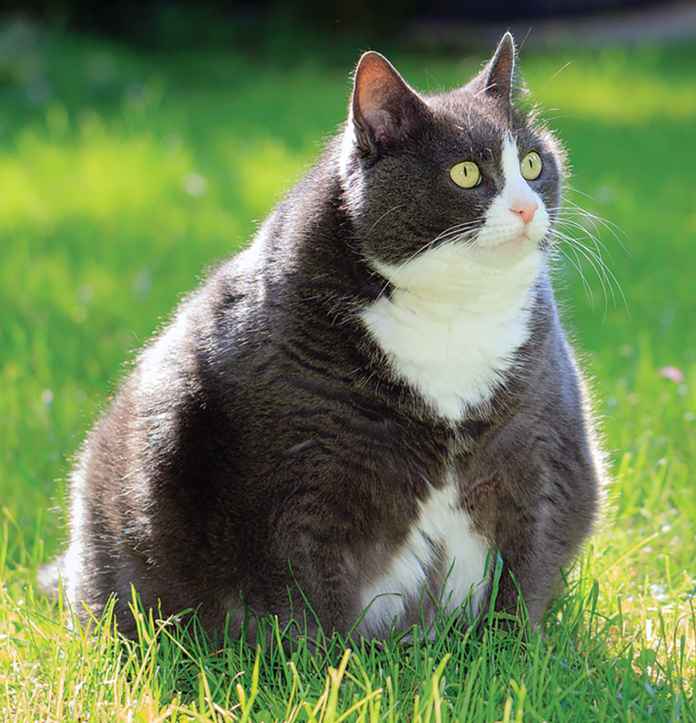Hepatic lipidosis, or fatty liver disease, is a potentially fatal illness that must be caught early and treated aggressively. The most common liver disease in cats, hepatic lipidosis results from inappetence, a serious lack of appetite. Affected cats usually begin with anorexia that may worsen with vomiting.
During the period of anorexia/inappetence, the liver tries to metabolize stored fats to keep the cat alive, but it rapidly becomes overwhelmed from handling too much fat. After six to seven weeks, untreated cats may die either because their brain stops functioning due to a lack of nutrients or because the liver becomes so overworked that it fails.
“Cats have a notable tendency to accumulate triglycerides in their hepatocytes (liver cells), and when these cells become filled with fat, the liver is unable to function properly. If not rescued promptly from the disease, affected cats don’t just end up with deformed livers—they die!” says Sharon Center, DVM DACVIM, James Law Professor of Internal Medicine and expert in veterinary liver disease in Cornell’s Department of Clinical Sciences.
The incidence of hepatic lipidosis appears to be highest in obese cats (see “Fat Cats: Obesity Isn’t Fun or Healthy,” December 2017, available at catwatchnewsletter.com), but even cats of a normal weight and in good health can develop hepatic lipidosis if they go off their food.
Most cats with hepatic lipidosis are middle-aged (6 to 12 years old), but 3-month-old kittens to 25-year-old cats have been diagnosed with this disease. While female cats and diabetic cats have slightly increased risks, there does not seem to be a breed predilection.
Causes
Hepatic lipidosis can result from any disease, environmental change, or stressful interaction that causes inappetence. Most cats with hepatic lipidosis (70–90%) have a primary disease involving the liver, although chronic or severe illnesses in any body system can trigger hepatic lipidosis.
The critical tipping point is anorexia or the failure of your cat to eat. When a cat stops eating, the body mobilizes fat stores for nutrition. However, this soon overwhelms the liver so it cannot properly metabolize the fats. Fat builds up in the cells of the liver, resulting in hepatic lipidosis.
Affected cats often become reclusive, says Dr. Center. “They will avoid their food bowl—won’t even go near it—as if they’re scared of it,” she says. “In fact, when they see it, they might move away quickly and just sit there salivating. Also, they may become jaundiced, with a yellowish tinge to the skin in their ears and their gums.”
Diagnosis
Diagnosing hepatic lipidosis starts with a thorough history that involves a cat not eating or not eating well (yet another reason why free feeding is not ideal in a multi-cat home). Commonly, owners state that cats have not been eating or not been eating well for two weeks and may have dropped up to 25% of their body weight. Don’t wait that long—if your cat has stopped eating for 24 to 36 hours, make a veterinary appointment!
A physical examination typically shows weight loss, jaundice, an enlarged liver, and muscle wasting (cachexia). Jaundice may be noted on the inside of your cat’s ears, gums, and around her eyes. In advanced cases, the skin has a yellow tone, too. Cats may display loss of cognitive function, severe lethargy, marked head/neck ventroflexion (head drops to the ground), and drooling. Severely affected cats also may show bruising and hemorrhages under the skin. Bloodwork and a urinalysis will commonly be done to evaluate liver function. An abdominal ultrasound can non-invasively suggest hepatic lipidosis via the appearance of the liver.
Treatment
Treatment focuses on getting the liver back on track with nutritional support in the form of high-quality protein, vitamins, essential amino acids, and electrolytes. Cats with ventroflexion of the neck often require extra electrolytes, such as potassium and phosphate, and thiamine (vitamin B1). Carnitine, an amino acid, may help mobilize fatty acids from the liver.
Nutritional support usually requires an esophageal feeding tube. “While a few cats can be recovered with an orally fed liquid feline-appropriate diet, if there is resistance to force feeding by oral route, this must be suspended,” says Dr. Center. “Initial treatment may be via a nasogastric tube. Ultimately, in most cats, the optimal route of feeding is via placement of an esophageal feeding tube. These are safe and easily managed by most owners. It is important to only pursue feeding tube placement when the cat is a reasonable candidate for anesthesia, which is usually not the first day of presentation.”
Many cats spend a week to 10 days in the veterinary hospital. Some cats will develop “refeeding syndrome,” which happens when the cat’s body shifts abruptly from a catabolic (starvation) state to the ingestion of a plethora of nutrients, especially carbohydrates. This syndrome is best identified while the cat is in the hospital. Potentially fatal decreases in blood potassium, phosphate, and magnesium can occur, along with a decrease in thiamine. The veterinary clinic will usually start your cat off with small amounts of food, gradually building up. Once your cat is past the critical stage, she should be able to continue treatment at home.
Most owners can be trained to maintain and clean esophagostomy and gastrostomy tubes at home. It is imperative to prevent your cat from interfering with or removing the tube, so bandaging and a collar of some sort are required. Most cats will require specialized nutritional therapy for at least a month to restore health to the liver. Your veterinarian will likely prescribe a high-quality protein diet.
Hepatic lipidosis can be fatal, but a decline in total blood bilirubin by 50% within the first seven to 10 days suggests an excellent chance of full recovery. Bilirubin is produced during the breakdown of red blood cells and then filtered through the liver to be excreted. High blood levels of bilirubin indicate liver disease. Luckily, hepatic lipidosis is not usually a recurrent disease. Although it’s an expensive, long process to save a cat with hepatic lipidosis, it is totally worth the effort.
Neutering and Obesity
While there is no known correlation between spaying or neutering and the development of hepatic lipidosis, spayed and neutered cats do seem to have a tendency toward obesity. Keep your cat trim and active right from the start.
Research Shows Promise
A study from the Netherlands found two potential drugs to help treat hepatic lipidosis in cats. This was an in vitro study performed on liver cells in a lab and not on live cats. Two drugs showed some promise: T863 and AICAR. Both medications act on enzymatic processes that might help cats with this condition. Obviously, many more studies will need to be done before these drugs are considered safe for cats battling hepatic lipidosis.
Journal of Veterinary Internal Medicine, 11 Dec 2019, 34(1):132-138



